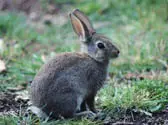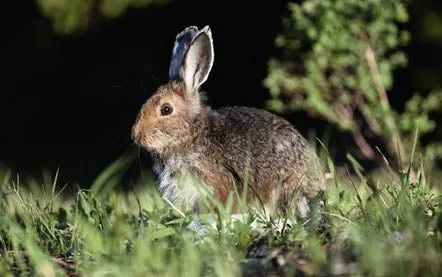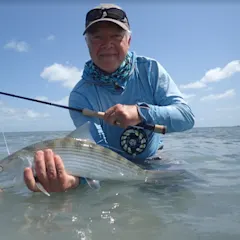
Field & Stream Online Editors
I don’t like to hunt with a hungry man,” Dungee Taylor says. He’s a bull-sized fellow, bald, with one foot in the briers and a grin on his face, but I can read between the lines. His comment is both a statement of fact and an admonition: Don’t shoot too soon. Let the dogs have their fun. After all, that’s the point of turning out 14 finely tuned beagles with a single thing on their minds-finding every rabbit on this patch of the planet.
“We’re not out here to shoot everything we see,” Taylor sings out. “We just want to teach these dogs how smart a rabbit really is.” And with that, both feet go into the briers, and 240 pounds of denim-clad rabbit hunter disappear into the tangled brambles along North Carolina’s Neuse River.
As I fight through curtains of thorny smilax and blackberry, the beagles worm through briers so thick a breeze couldn’t sneak through-an entire dog pack reduced to white-tipped tails semaphoring in the brush. Good rabbit dogs rely on their eyes as much as their noses. At times I can see them looking for game; they burrow their snouts into every nook and cranny, then suddenly their heads are up, eyes dissecting the thicket for any sign of a rabbit. I can hear their heavy snorting as they siphon the air for scent.
They’re hot onto something, but it seems to me that they’ve covered every inch of ground to no avail. Then Cassie, Taylor’s “A-number-one jump dog,” suddenly pushes a bunny from its bed not 10 feet from my bootlaces. Cassie opens up with a bawling cry. In seconds the rest of the pack honors the find, rushing to the hot scent. Rip booms out a guttural bass line of affirmation. PeeWee and Blondie add their high-pitched “chop” (see sidebar) to the chorus. The pack is off, and the race is on.
Run, Rabbit, RunRabbit hunting with beagles is a coast-to-coast American tradition. From the alder thickets of the Northeast Kingdom of Vermont to the Mojave Desert scrub, from Dixie’s swamp woods to the Midwest’s endless farms, the sport assumes the vernacular character of whatever field it’s played on. It can be done with one dog or a large pack. But a few things hold, no matter the region. Rabbit hunting is a congenial pursuit, commonly undertaken by a small group of hunters whose connections to each other cross multiple generations. It demands a chess player’s logic and a gunslinger’s reflexes.
Square off with a wild rabbit, and the deck is firmly stacked against you. Cottontails can exhibit blazing speed-they run up to 35 mph-and when that’s not enough of a safety margin, they call on agility, camouflage, and an impressive capacity for strategic thinking. Rabbits feed mostly at night, and dawn finds them slinking into the thickest, gnarliest brier-thatched cover they can find. On cold days they seek a sunny, south-facing slope. There they hollow out a small bowl-shaped nest called a form and hunker down until dark.
[NEXT “Continued…”] The one chink in the rabbit’s armor, however, is its well-known habit of circling back to the very patch of ground where it was jumped. A prize rabbit dog-using its extraordinary sense of smell-can pinpoint the loafing bunny, startle it to a chase, and ultimately run it past the hunter on stand.
Of course, a lot can happen between the first bawling cry of a beagle and the crack of a shotgun, and Taylor has seen it all. Now 49 years old, he learned to rabbit hunt under the eyes of his grandfather, who would place him against a sturdy tree so the recoil of a 12-gauge wouldn’t knock the 6-year-old boy down. “I just fell in love with it,” Taylor recalls.
The Taylor family is still known for its love of beagle packs, and Dungee’s father, Edward, and uncle Bill still hunt with him. “Growing up,” his uncle Bill tells me, “we were hunting for the pot. And we hunted rabbits, coons, possums, and any bird big enough to clean.” Days spent behind a mule and plow were followed by nightshasing dogs through the big woods, and the dogs were in the game for more than sport, too. “Back then the dogs were poor-hungry all the time-and they would run the daylights out of anything, yes, sir,” Bill says. He grins behind dark sunglasses, his smile turning the corners of trim lambchop sideburns. The beagles weren’t the only ones with limited resources. “We didn’t hardly have any shells. We used sticks, rocks, whatever we could to save those shells. The dogs would run ’em so hard, they’d go into holes, and that’s what you wanted them to do. We’d just dig them up.”
**Dogging It **These days, of course, running bunnies with beagles has more to do with the hunt and the hound music than filling an empty belly, and modern rabbit hunters have definite-and differing-ideas about what makes a good dog tick. Some dogs are particularly adept at scent trailing once a rabbit hits the road; others make a name for themselves through an ability to find and jump rabbits from the bed. When a rabbit changes course dramatically, some dogs naturally tend to hunt back and forth for the new scent trail. Others stay on the track, noses glued to the ground, and take longer to decipher the mystery.
With hounds in pursuit, a rabbit first pours on the speed to gain ground and a little bit of thinking room. That’s when the fun begins. Cottontails are notorious for their cunning when chased, and their daring tricks to throw off the dogs are legendary. “I’ve seen them do crazy things,” Taylor tells me as we break through the thicket to find a clearing for a stand. “Those rabbits will run full bore for a few hundred feet, then hop to the side and squat down tight as the dogs race by just a hand’s width away.” A rabbit on the run will suddenly spin 180 degrees, step to the side of its trail, and come running right back at a pack of tonguing dogs too intent on scent to notice the bunny. “He’ll lick his feet real good to clean them off, then slip through the woods to sit up by some tree, and the dogs will never find him,” Taylor says. Swamp rabbits will lie underwater alligator-style, with only their eyes and noses above the surface. Cottontails squirt through hollow logs, then hop to the top of the fallen trunk and head the other way.
[NEXT “Continued…”] Of course, it’s not a dog’s game alone. After the first few hours of daylight, the scent trails laid by feeding bunnies diminish, and hunters can jump as many rabbits as the beagles. “You’ve got to get in there with them,” Taylor says. He kicks every downed treetop and hummock of grass. Rabbits will hide in culverts, drainage pipes, tree hollows, and ground burrows. He pokes and prods the shadows and looks for droppings and cuttings-shoots of greenbrier and blackberry cleanly snipped off at a 45-degree angle, showing that a bunny was snacking in the neighborhood.
They say a man’s dogs are a reflection of him, and that’s clearly the case with Taylor, who owns a moving company in Durham, North Carolina. “I just can’t stand still. I’ve got to be moving, got to be moving, all the time,” he says, each sentence a volley that chases the one before. “And that’s how my dogs are. I want them pushing that rabbit. Don’t give him too much time to think and duck those dogs. When they run like that, you don’t hear nothing but sweet music.”
**Fast Action **At the moment, the music means a rabbit is headed my way, and fast. I take up a stand at the intersection of two trails. Robert Steed, Taylor’s boyhood friend and hunting partner, is 40 yards away. “That rabbit comes running at you,” he hollers, “you shoot at the ground in front of him, you hear?” I nod.
The dogs are in full cry, baying like a dozen cars locking up the brakes, moments before impact. When the rabbit squirts out of the brambles, it gives me a glancing look, then leaps across the trail. My shotgun bead points at an empty spot in the woods. Now the bunny takes two hops and spins like a top. It nearly runs over Steed’s feet, ducks into the brambles, and is gone.
There will be more rabbits to come, and a few that aren’t so lucky. But for now we haven’t fired a shot, and all we can do is grin.
“That rabbit, now, he’s a smart one,” Taylor says, wiping the sweat from his brow as Rip, Brenda, LaVerne, and the gang go tearing off again. “Don’t think he ain’t.”
[NEXT “Continued…”] Dog TalkA Beagle Owner’s GlossaryJump dogs: Dogs known for their ability to find bunnies and jump them from their beds.
Track dogs: When the scent trail goes cold, these dogs stay the course, working the track close to figure out where the rabbit ran. Also called trail dogs or pickers.
Swing dogs: These dogs range back and forth in an attempt to pick up a lost trail. A good pack will have both track dogs and swing dogs.
Cast: To put the dogs in a hunting situation; in reference to a single dog, to hunt intensely for a rabbit, as in “The beagle cast back and forth.”
**Check: **To lose the scent trail. Also describes a change of course or tactics employed by the rabbit.
**Line control: **The ability of a dog to stay close to the scent trail.
**Tailing: **A dog’s watching its packmates to see what to do instead of hunting on its own.
**Tongue: **The special voice of a rabbit dog on a scent, which will change along with conditions on the trail.
**Babbling: **A hound’s tonguing or “opening up” indiscriminately.
Chop mouth: A short, choppy, staccato style of tonguing, also called machine-gun. Opposite of bawl mouth, which is characterized by a big, booming tongue.
Tight mouth: Describes a dog that tongues only when on a scent.wo hops and spins like a top. It nearly runs over Steed’s feet, ducks into the brambles, and is gone.
There will be more rabbits to come, and a few that aren’t so lucky. But for now we haven’t fired a shot, and all we can do is grin.
“That rabbit, now, he’s a smart one,” Taylor says, wiping the sweat from his brow as Rip, Brenda, LaVerne, and the gang go tearing off again. “Don’t think he ain’t.”
[NEXT “Continued…”] Dog TalkA Beagle Owner’s GlossaryJump dogs: Dogs known for their ability to find bunnies and jump them from their beds.
Track dogs: When the scent trail goes cold, these dogs stay the course, working the track close to figure out where the rabbit ran. Also called trail dogs or pickers.
Swing dogs: These dogs range back and forth in an attempt to pick up a lost trail. A good pack will have both track dogs and swing dogs.
Cast: To put the dogs in a hunting situation; in reference to a single dog, to hunt intensely for a rabbit, as in “The beagle cast back and forth.”
**Check: **To lose the scent trail. Also describes a change of course or tactics employed by the rabbit.
**Line control: **The ability of a dog to stay close to the scent trail.
**Tailing: **A dog’s watching its packmates to see what to do instead of hunting on its own.
**Tongue: **The special voice of a rabbit dog on a scent, which will change along with conditions on the trail.
**Babbling: **A hound’s tonguing or “opening up” indiscriminately.
Chop mouth: A short, choppy, staccato style of tonguing, also called machine-gun. Opposite of bawl mouth, which is characterized by a big, booming tongue.
Tight mouth: Describes a dog that tongues only when on a scent.






